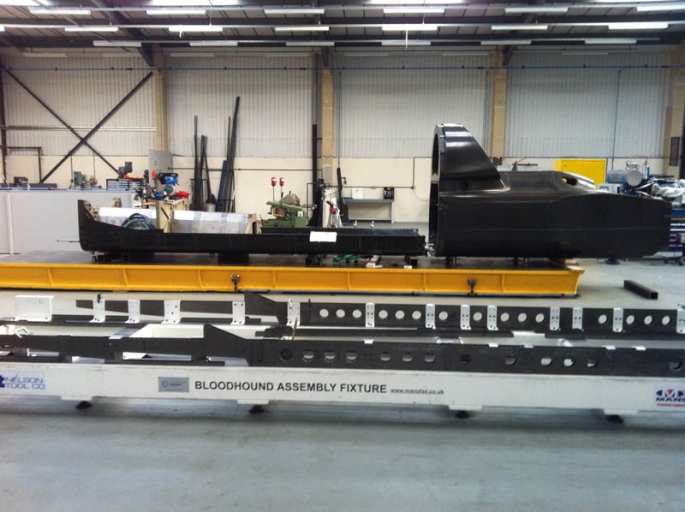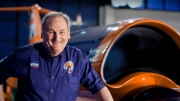Nick Chapman’s on my back again: time for another update! Andy seems to be able to do his BBC updates religiously every month and I struggle to get one out four times a year!
Towards the end of last month I asked Andy what he thought of the Bloodhound engineering since he has been able to attend most of the engineering meetings right from the very start of the project: ‘It's very very good, it’s a very fine car and it’s going to achieve its objectives.’
Growing the company at this rate (300% this year) is a truly painful experience, but we have to go through this otherwise the car build will never get finished. It’s a big programme with over 200 companies involved and because the car is being designed and built to aircraft standards, and financed by sponsorship and public support, it needs to get finished and operational before everyone gets bored of talking about Bloodhound and the cashflow goes into decline. We have the normal corporate problems linked with rapid growth. Not so long ago we were a small company everyone knew everyone and the project was best run on an intense but informal basis. Now we can’t do that any more, the company is expanding fast on a wide range of fronts and accurate communication is more difficult but absolutely vital. Not just accurate communication but a general team understanding of the absolute need to communicate. As new sponsors join so they have new and different objectives and all this needs to be taken into account. On top of all that there are of course activities which go wrong and have to be fixed – so the workload accumulates at a massive pace – much greater than just 300%. It is essential to hit problems as soon as they emerge and not let them grow like weeds and stifle productive activity.
What is interesting is that the UK aerospace companies find it difficult to reconcile the scale of the project with the small size of the design and build team. But Chris Dee who runs the assembly programme is confident – there are a large number of highly skilled people lining up to work on Bloodhound - we are not going to be short.
One of my major concerns is planning – when are we going to get the car? How much money do we need to complete the build? In the old days when we were a small team with a massive project and a huge number of unknowns, we could only plan six or seven weeks ahead. The rest of the programme was off our horizon and too difficult to plan in detail for a design which was still in gestation. Now we are much larger, the project is well advanced and the number of engineering unknowns is dropping off very quickly, we are in a position to plan much more tightly and given the monthly cashflow and the sponsors needs, this is absolutely essential. The difficulty with tight in-house planning is that everyone has their own ideas and broadly as you might expect we have the optimists and the pessimists. A quick solution was needed and Mary Mckinlay one of our keenest Ambassadors and a key member of the Association of Project Managers came up with the solution – you need BMT-Hi-Q Sigma. They specialise in planning complex engineering programmes and are one of the best in the business. A visit to Dean Taylor in Bath found us an immediate and highly experienced industrial planning team and now we are going to get a quality independent plan. Once we have that plan we have to stick with it and meet all the milestones . And we’ll publish the key milestones on the web so you can track us.
 On May 13th, Rolls-Royce announced their financial sponsorship - this was a truly magic moment for us. The announcement was made at Rolls-Royce Filton and the presentation was by Colin Smith Director of Engineering and Technology. There was a very solid media turnout and Colin explained that the reason Rolls-Royce was doing this was because of the severe shortage of engineers and scientists. With the advent of the new highly efficient civil airliners (B787, A380, A350) fuel burn and operating costs are set to drop substantially and there is going to be a massive demand for the new planes, which are likely to generate serious profits for the airlines. Some airlines already charge premium rates for flights on the A380. Rolls-Royce needs the engineers and scientists for their huge supply chain which will have to grow substantially to meet the aero engine demand. Colin’s speech was very much an endorsement for what we are trying to achieve; he focussed almost entirely on the education. Later that day we had an opportunity to meet many of the Rolls-Royce Filton site team who were absolutely amazed and very thrilled that Rolls-Royce Board had taken the decision. Today the Bloodhound Show Car has Rolls-Royce on the upper fuselage just where the EJ200 is positioned.
On May 13th, Rolls-Royce announced their financial sponsorship - this was a truly magic moment for us. The announcement was made at Rolls-Royce Filton and the presentation was by Colin Smith Director of Engineering and Technology. There was a very solid media turnout and Colin explained that the reason Rolls-Royce was doing this was because of the severe shortage of engineers and scientists. With the advent of the new highly efficient civil airliners (B787, A380, A350) fuel burn and operating costs are set to drop substantially and there is going to be a massive demand for the new planes, which are likely to generate serious profits for the airlines. Some airlines already charge premium rates for flights on the A380. Rolls-Royce needs the engineers and scientists for their huge supply chain which will have to grow substantially to meet the aero engine demand. Colin’s speech was very much an endorsement for what we are trying to achieve; he focussed almost entirely on the education. Later that day we had an opportunity to meet many of the Rolls-Royce Filton site team who were absolutely amazed and very thrilled that Rolls-Royce Board had taken the decision. Today the Bloodhound Show Car has Rolls-Royce on the upper fuselage just where the EJ200 is positioned.
Sadly we couldn’t continue the Bloodhound assembly in our old building at the harbour in Bristol. I liked the place with its views over the ever active Bristol harbour and its position next to Brunel’s SS Great Britain. Bloodhound was quickly going to get too big for the building and we needed to include all our workshop and support equipment also. We were going to have to build much more of the car in house because the early plan to invite contractors to design and manufacture large assemblies was a non-starter. Neil Gallagher from REME did us a fine job finding the new Avonmouth building which is about 5 miles away. A huge effort was needed by everyone to get the building ready – but as I write this, the offices and wiring are complete and the Bloodhound lower chassis and front carbon tub are now mounted on the surface table, and for the first time we can see the sheer scale of what is being achieved.
'It's really big!' said design engineer Mark Elvin.'I have to double check my measurements as I am just used to seeing Bloodhound on my CAD screen!'
In fact what really comes across to me is the power density of the car. Every cubic centimetre is packed with powerplant or powerplant accessories and the quality of build is absolutely exceptional. Bloodhound is going to be a vehicle of which we can all be very proud.
It’s quite clear now that the build is going to progress fast. Just as Mark Chapman and the design team planned, there are large numbers of drawings about to be released and then it's Conor La Grue’s job to get the parts manufactured as quickly as possible to meet Chris Dee’s demands for the parts delivered on time to meet his assembly schedule. Next week we are all going to be in the new building and together we can see how the programme is progressing. As long as Chris and the Assembly team are driving ahead, we are doing OK. If they slow and look as though they are waiting for parts – our system is failing them.

It’s rained again on the Hakskeen Pan which is good news and means that the 2014 surface will be even better. Our Met office weather station is now operational and every week Aubrey Mouton who manages the local desert team drives out to give us a report on the surface condition. Today the surface is dry and the midday temperature is still high at 29 degrees as they approach the winter months. Nico Fourie who manages the whole desert programme expects to have the team back on the desert in early July for the last 35 days or so of desert preparation. Our tremendous South African sponsors MTN are pushing ahead now with the erection of the 5 x 60m high radio masts which will take Bloodhound data and video channels to Upington where they join the internet.
Helmet competition entries - South African style
Back in Kimberley we are waiting for the Northern Cape Government’s operational contract which should be with us very shortly. They have also expressed interest in having their own Bloodhound show car which will be hugely helpful with local promotions. In both South Africa and UK, the education teams have come up with a clever promotion; Andy Green is to have two helmets and each is to have a different school pupil's created paint scheme. In UK we have received over 500 designs and in South Africa there are 400 entries – this is quite something and indicative of how the education is really taking hold.
Bloodhound is now being followed in 219 countries and it is interesting to see that the web response from South Africa is growing really fast, putting the country in the number 3 slot after UK and the US.
Finance is always a nightmare on a project like this and the build is a particularly difficult time. We have fought Bloodhound through the worst recession in the last 100 years, but that was design and research - the build of the car with its massively increased cashflow is something else. The build of these cars is not like a production job where every item is tightly costed and the assembly time well learned or even predictable Here we have a car with some 3,000 bespoke parts almost all of which are one offs and it takes time to design and stress the parts, have them manufactured and then put them all together. Using 3D CAD design all the parts should go together easily but we are still going to need hand made ‘knife and fork parts’ and this is where the REME machine tools section in the corner of the Avonmouth building is going to be vital. On a production line we would be working to an 85% learning curve (where the assembly hours drop by 15% for every successive production unit) - but here we are only building one!
So when we looked at the accounts after the first three months of 2013, we were only slightly overspent on the financial plan, which is very encouraging bearing in mind we have all the costs of sorting the new building. Very shortly we will have the new last stage build plan and we can tighten up on the financial plan.
Bill Marquardt was a close associate and friend of the late Steve Fossett and there are rumours that they plan to run the ex Breedlove/Fossett car now named as American Avenger later this year. This could be a tremendous curtain raiser to the entire show; the car has already run to around Mach 0.9 with Breedlove at the wheel and after all the improvements there is the general view that 800mph is a distinct possibility.
Following the Rolls-Royce announcement, many of the long term sponsorship deals are coming together. Looking back over our internal reports it seems that many of these deals have taken five years of persistent negotiation. It seems incredible but that’s the reality of it all - the whole programme is just a huge counter culture fight to survive and succeed. But we are getting there now with a further 11 deals under negotiation. Rolls-Royce have been with the project since 2008 and they know all the key engineering data. I can imagine a prospective sponsor’s board debating whether they should become involved. At some stage one of the directors will ask the inevitable :
1. How do we know that Bloodhound is safe?
2. How do we know whether Bloodhound is capable of 1000mph?
The fact that Rolls-Royce has been with us so long and endorsed the programme with its sponsorship and brand must go some way to providing answers.
On May 26th, we had the first 1K club day at Avonmouth. With the new building Ian Glover was able to invite the first group of 100. We asked the how many had been to a 1K meeting before and only a few hands went up – this was very good news, it demonstrated that we are not presenting to the same people all the time. The 1K club is absolutely essential to the project – it enables interested followers to get close to the project and the team and experience the development of the project at first hand, together with all its excitement and inevitable difficulties. We have just over 5,000 members and over the long years we have not been able to run as many of these Sunday events as we wished. Now we are setting out to run one a month. Ian had our new polo shirts, models and Augmented Reality on display and we were all delighted to sign a large number of the Rolex books. Quite a number of the 1K visitors showed interest in joining us as Ambassadors - and that’s very good news. Seema tells us that we are now up to 500 ambassadors and next month we will have the next Ambassadors conference.
Jo Finch gave us a fine spirited presentation on Bloodhound BLAST - our new communities website in development. This is fascinating cutting edge innovation and seems to be set for massive growth. Nick Chapman describes BLAST best: 'If you think of the Bloodhound website as the project's magazine - then the BLAST part is the conversation!’
The Bloodhound Educational Team now have 5442 UK schools, colleges and universities signed with a further 240 in South Africa. There is a huge swell of activity in South Africa almost all created by Dave Rowley and Wendy Maxwell who drive astronomic mileages as they criss-cross the country presenting Bloodhound at schools and events.
At the end of the 1K Club day, Ron Ayers and I ran a mini seminar with school kids from Bishops Canning Primary School (nr Devizes) with Chris Henley a primary school teacher of many years experience and one of our star Ambassadors. The school have their own Bloodhound Club and it was amazing how quickly the kids had picked up the engineering detail and understood it. They seemed to have a very genuine understanding and answer for everything. There is a very good reason for all this because of their very extensive website. If you want to see how Chris and the school achieved all this just spend a few minutes on their website www.bloodhoundclub.org.uk. In the end we ran out of questions - the kids were still going strong!! So this is what Bloodhound education is all about This is how you create real change.
So now the project is well set for the push through to completion of Bloodhound SSC. We are going to get the plan in three weeks and then we’ll know when we are going to get the car. And we’ll know how much the rest of the build is going to cost …
In the meantime very good luck to our friends at American Avenger, we look forward to some very positive avenging !!
Richard Noble, © Bloodhound Programme Ltd
May 2013



